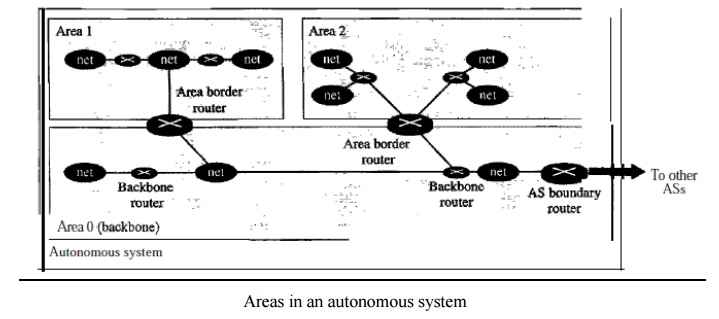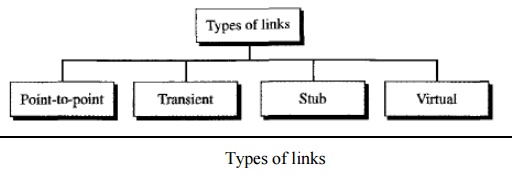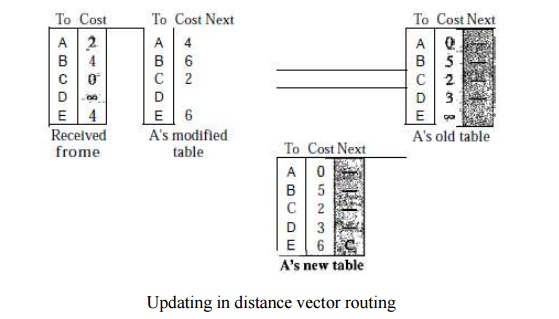Chapter: Mobile Computing : Mobile ADHOC Networks
Essential of Traditional Routing Protocols
ESSENTIAL OF TRADITIONAL ROUTING
PROTOCOLS
Link State Routing Protocol
Link
state routing has a different philosophy from that of distance vector routing.
In link state routing, if each node in the domain has the entire topology of
the domain the list of nodes and links, how they are connected including the
type, cost (metric), and condition of the links (up or down)-the node can use
Dijkstra's algorithm to build a routing table.

Concept
of link state routing
The figure shows a simple domain with five nodes.
Each node uses the same topology to create a routing table, but the routing
table for each node is unique because the calculations are based on different
interpretations of the topology. This is analogous to a city map. While each
person may have the same map, each needs to take a different route to reach her
specific destination.
The topology must be dynamic, representing the
latest state of each node and each link. If there are changes in any point in
the network (a link is down, for example), the topology must be updated for
each node.
Building Routing Tables
In link
state routing, four sets of actions are required to ensure that
each node has the routing table
showing the least-cost node to every other node.
1. Creation
of the states of the links by each node, called the link state packet (LSP).
2. Dissemination
of LSPs to every other router, called flooding,
in an efficient and reliable way.
3. Formation
of a shortest path tree for each node.
4. Calculation
of a routing table based on the shortest path tree.
Creation of Link State Packet
(LSP)
A link
state packet can carry a large amount of information. For the moment, however,
we assume that it carries a minimum amount of data: the node identity, the list
of links, a sequence number, and age. The first two, node identity and the list
of links, are needed to make the topology. The third, sequence number, facilitates
flooding and distinguishes new LSPs from old ones. The fourth, age, prevents
old LSPs from remaining in the domain for a long time. LSPs are generated on
two occasions:
1. When
there is a change in the topology of the domain. Triggering of LSP dissemination
is the main way of quickly informing any node in the domain to update its
topology.
2. On a
periodic basis. The period in this case is much longer compared to distance
vector routing. As a matter of fact, there is no actual need for this type of
LSP dissemination.
It is done to ensure that old information is
removed from the domain. The timer set for periodic dissemination is normally
in the range of 60 min or 2 h based on the implementation. A longer period
ensures that flooding does not create too much traffic on the network.
Flooding of LSPs After a node has prepared an LSP,
it must be disseminated to all other nodes, not only to its neighbours. The
process is called flooding and based on the following:
1. The
creating node sends a copy of the LSP out of each interface.
2. A node
that receives an LSP compares it with the copy it may already have. If the
newly arrived LSP is older than the one it has (found by checking the sequence
number), it discards the LSP. If it is newer, the node does the following:
a. It
discards the old LSP and keeps the new one.
b. It
sends a copy of it out of each interface except the one from which the packet
arrived. This guarantees that flooding stops somewhere in the domain (where a
node has only one interface).
Formation of Shortest Path Tree
Dijkstra Algorithm After receiving all LSPs, each
node will have a copy of the whole topology. However, the topology is not
sufficient to find the shortest path to every other node; a shortest path tree
is needed.
A tree is a graph of nodes and links; one node is
called the root. All other nodes can be reached from the root through only one
single route. A shortest path tree is a tree in which the path between the root
and every other node is the shortest. What we need for each node is a shortest
path tree with that node as the root.
The
Dijkstra algorithm creates a shortest path tree from a graph. The algorithm
divides the nodes into two sets: tentative and permanent. It finds the
neighbours of a current node, makes them tentative, examines them, and if they
pass the criteria, makes them permanent. The following shows the steps. At the
end of each step, we show the permanent (filled circles) and the tentative
(open circles) nodes and lists with the cumulative costs.





OSPF
The Open
Shortest Path First or OSPF protocol is an intra domain routing protocol based
on link state routing. Its domain is also an autonomous system. Areas To handle
routing efficiently and in a timely manner, OSPF divides an autonomous system
into areas. An area is a collection of networks, hosts, and routers all
contained within an autonomous system. An autonomous system can be divided into
many different areas.
All
networks inside an area must be connected. Routers inside an area flood the
area with routing information. At the border of an area, special routers called
area border routers summarize the information about the area and send it to
other areas. Among the areas inside an autonomous system is a special area called
the backbone; all the areas inside an autonomous system must be connected to
the backbone. In other words, the backbone serves as a primary area and the
other areas as secondary areas.
This does
not mean that the routers within areas cannot be connected to each other,
however. The routers inside the backbone are called the backbone routers. Note
that a backbone router can also be an area border router. If, because of some
problem, the connectivity between a backbone and an area is broken, a virtual
link between routers must be created by an administrator to allow continuity of
the functions of the backbone as the primary area.Each area has an area
identification. The area identification of the backbone is zero. Below Figure
shows an autonomous system and its areas.

Areas in
an autonomous system
Metric
The OSPF
protocol allows the administrator to assign a cost, called the metric, to each
route. The metric can be based on a type of service (minimum delay, maximum
throughput, and so on). As a matter of fact, a router can have multiple routing
tables, each based on a different type of service. Types of Links In OSPF
terminology, a connection is called a link. Four types of links have been
defined: point-to-point, transient, stub, and virtual.

Types of
links
A
point-to-point link connects two routers without any other host or router in
between. In other words, the purpose of the link (network) is just to connect
the two routers. An example of this type of link is two routers connected by a
telephone line or a T line. There is no need to assign a network address to
this type of link. Graphically, the routers are represented by nodes, and the
link is represented by a bidirectional edge connecting the nodes. The metrics,
which are usually the same, are shown at the two ends, one for each direction.

Point-to-point
link
A
transient link is a network with several routers attached to it. The data can
enter through any of the routers and leave through any router. All LANs and
some WANs with two or more routers are of this type. In this case, each router
has many neighbors. For example, consider the Ethernet in Figure. Router A has
routers B, C, D, and E as neighbors. Router B has routers A, C, D, and E as
neighbors.

Transient
link
A stub link is a network that is
connected to only one router. The data packets enter the network through this
single router and leave the network through this same router. This is a special
case of the transient network. We can show this situation using the router as a
node and using the designated router for the network.

When the
link between two routers is broken, the administration may create a virtual link between them, using a longer path that probably goes through
several routers. Graphical
Representation Let us now examine how an AS can be represented graphically.
Figure shows a small AS with seven
networks and six routers. Two of the networks are point-to-point networks. We
use symbols such as Nl and N2 for transient and stub networks. There is no need
to assign an identity to a point-to-point network. The figure also shows the
graphical representation of the AS as seen by OSPF.

Distance Vector Routing Protocol
Routing Information Protocol (RIP) is an
implementation of the distance vector protocol. Open Shortest Path First (OSPF)
is an implementation of the link state protocol.
Border
Gateway Protocol (BGP) is an implementation of the path vector protocol.
In
distance vector routing, the least-cost route between any two nodes is the
route with minimum distance. In this protocol, as the name implies, each node
maintains a vector (table) of minimum distances to every node. The table at
each node also guides the packets to the desired node by showing the next stop
in the route (next-hop routing).
Distance vector routing tables

Initialization
The table for node A shows how we can reach any
node from this node. For example, our least cost to reach node E is 6. The route
passes through C. Each node knows how to reach any other node and the cost.
Each node can know only the distance between itself and its immediate
neighbors, those directly connected to it.
So for
the moment, we assume that each node can send a message to the immediate
neighbors and find the distance between itself and these neighbors.

Sharing -
In distance vector routing, each node shares its routing table with its
immediate neighbors periodically and when there is a change.
Updating -
When a node receives a two-column table from a neighbor, it needs to update its
routing table.
Updating
takes three steps:
1. The
receiving node needs to add the cost between itself and the sending node to
each value in the second column. The logic is clear. If node C claims that its
distance to a destination is x mi, and the distance between A and C is y mi,
then the distance between A and that destination, via C, is x + y mi.
2. The
receiving node needs to add the name of the sending node to each row as the
third column if the receiving node uses information from any row. The sending
node is the next node in the route.
3. The
receiving node needs to compare each row of its old table with the
corresponding row of the modified version of the received table.
a. If the
next-node entry is different, the receiving node chooses the row with the
smaller cost. If there is a tie, the old one is kept.
b. If the
next-node entry is the same, the receiving node chooses the new row. For
example, suppose node C has previously advertised a route to node X with
distance 3. Suppose that now there is no path between C and X; node C now
advertises this route with a distance of infinity Node A must not ignore this
value even though its old entry is smaller. The old route does not exist any
more. The new route has a distance of infinity.

Each node
can update its table by using the tables received from other nodes. When to
Share:
Periodic Update A node
sends its routing table, normally every 30 s, in a periodic update. The period depends on the protocol that is
using distance vector routing.
Triggered Update A node
sends its two-column routing table to its neighbors anytime there is a change in its routing table. This is
called a triggered update.
The
change can result from the following.
1. A node
receives a table from a neighbor, resulting in changes in its own table after
updating.
2. A node
detects some failure in the neighboring links which results in a distance
change to infinity.
RIP
The Routing Information Protocol (RIP) is an
intra-domain routing protocol used inside an autonomous system. It is a very
simple protocol based on distance vector routing. RIP implements distance
vector routing directly with some considerations:
1. In an
autonomous system, we are dealing with routers and networks (links). The
routers have routing tables; networks do not.
2. The
destination in a routing table is a network, which means the first column
defines a network address.
3. The
metric used by RIP is very simple; the distance is defined as the number of
links (networks) to reach the destination. For this reason, the metric in RIP
is called a hop count.
4. Infinity
is defined as 16, which means that any route in an autonomous system using RIP
cannot have more than 15 hops.
5. The
next-node column defines the address of the router to which the packet is to be
sent to reach its destination.
Related Topics